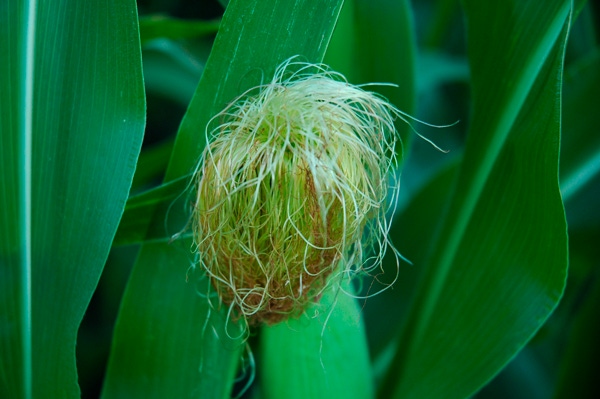July 22, 2015

The pollination period, the flowering stage in corn, is the most critical period in the development of a corn plant from the standpoint of grain yield determination. Stress conditions (such as hail damage and drought) have the greatest impact on yield potential during the reproductive stage.
This year’s excessive rainfall has resulted in highly variable conditions within cornfields with regard to saturated soils and ponding, which may impact uniformity of pollination. The NASS Ohio report indicated that 65% of the fields surveyed were characterized by surplus topsoil moisture. In a recent Purdue newsletter article, Bob Nielsen observed that the development of ear shoots removed from stunted, waterlogged plants was distinctly delayed relative to those from healthier plants. He noted that the latter were in the early stages of silk emergence (R1), while those of the nearby stunted plants were only in the initial stages of silk elongation within the husk leaves, and surmised that silk emergence of stunted plants would likely be at least a week delayed. In Ohio, uneven pollination may be more pronounced in corn planted in late May, which is generally exhibiting more waterlogging damage.
One of the concerns some growers have is that persistent rains will wash pollen off the silks before fertilization occurs. However, pollen shed is not a continuous process. It stops when the tassel is too wet or too dry and begins again when temperature conditions are favorable. Pollen stands little chance of being washed off the silks during a rainstorm as little to none is shed when the tassel is wet. Also, silks are covered with fine, sticky hairs, which serve to catch and anchor pollen grains.
Under favorable conditions, pollen grain remains viable for only 18-24 hours. However, the pollen grain starts growth of the pollen tube down the silk channel within minutes of coming in contact with a silk and the pollen tube grows the length of the silk and enters the female flower (ovule) in 12 to 28 hours. A well-developed ear shoot should have 750 to 1,000 ovules (potential kernels) each producing a silk. The silks from near the base of the ear emerge first and those from the tip appear last. Under good conditions, all silks will emerge and be ready for pollination within 3 to 5 days and this usually provides adequate time for all silks to be pollinated before pollen shed ceases.
Pollen of a given plant rarely fertilizes all the silks of the same plant. Under field conditions, 97% or more of the kernels produced by each plant may be pollinated by other plants in the field. The amount of pollen is rarely a cause of poor kernel set. Each tassel contains from 2 to 5 million pollen grains, which translates to 2,000 to 5,000 pollen grains produced for each silk of the ear shoot. Shortages of pollen are usually only a problem under conditions of extreme heat and drought. As noted above, poor kernel set is more often associated with poor timing of pollen shed with silk emergence – with silks emerging after pollen shed (poor “nick”). However, hybrids rarely exhibit this problem unless they experience extreme drought stress. Some of the new drought-tolerant hybrids have shorter “anthesis silking intervals”, i.e. pollen shedding and silk emergence are more closely synchronized, than hybrids more susceptible to drought. This shorter anthesis silking interval may mitigate the impact of drought stress during pollination.
You May Also Like




